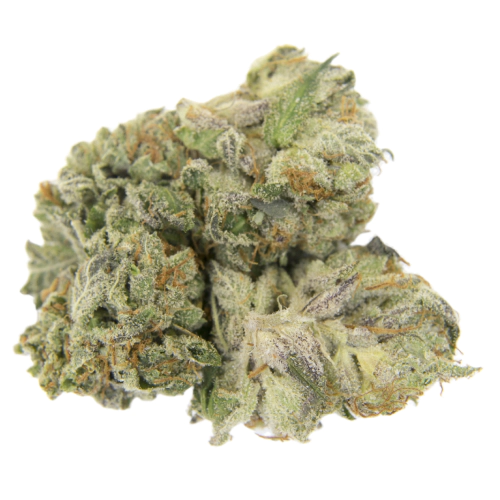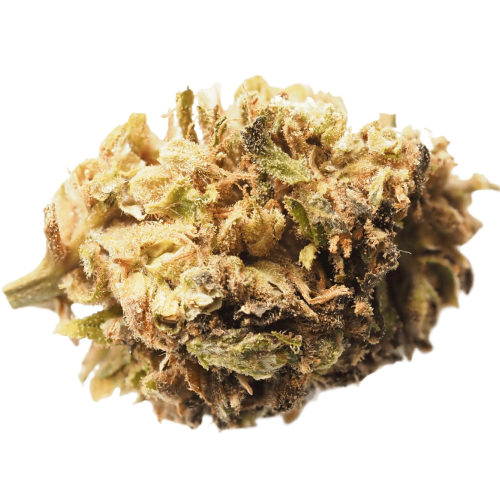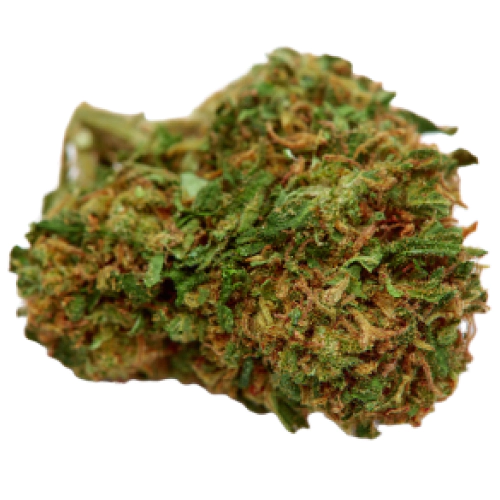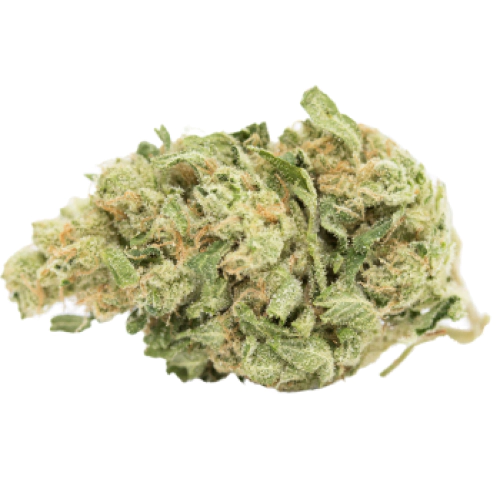
THC 18.25 - 22.25%
CBD 0.46 - 0.7%
Effect Happy
Flavor Diesel
12.5 - 16%
0.44 - 0.73%
0.22 - 0.51%
Berry, Pungent
Relaxed
Cherry Cream Pie is a well-balanced hybrid with a slight Indica dominance of 60%. The parent of this weed is Cherry Pie cannabis which is known for its sweet and refreshing taste on the exhale. The THC level of this strain is around 12,5–16%, and CBD concentration is not higher than 0,44–0,73%. Cannabinoids that the plant, with its therapeutic benefits, synthesizes are as follows:
Phellandrene and caryophyllene are the terpenes that are most prevalent in the Cherry Cream Pie strain. In addition to these, carene, pinene, myrcene, linalool, humulene, and limonene all have an impact on the aroma and effect of the weed strain in question.
Cherry Cream Pie flavors are as sweet and fresh as one might expect from the name. Inhale, and you'll be greeted by floral notes accompanied by green tea, apples, honey, and grapes. A more complex aroma blend is detected by marijuana smokers upon closer inspection. This aroma blend contains a combination of diesel and spicy herbal notes as well as coffee, pepper, and tobacco flavors, all of which are enhanced by an intense earthy undertone.
The relaxing effects of Cherry Cream Pie's strain can be felt throughout the body and mind alike.
For example, it increases creativity and concentration, arouses you, and "makes the heart lighter," among other things.
On the other hand, the sensation of happiness is accompanied by a sense of hunger (which will be helpful for people who have appetite problems). Consuming Cherry Cream Pie weed at the end of the day is the best time to do so because couch-lock is one of the most common side effects that can occur after ingestion.
This weed strain has a variety of health benefits and can be used to provide short-term relief from symptoms caused by the following conditions:
After your first exhale, you will feel a happy lift in your spirits, as well as a slight heaviness behind your eyes, which will leave you hazy and introspective with red, droopy eyes after you have finished smoking. It does not take long for this relaxing state to spread throughout the rest of your body, resulting in a buzzy body high that leaves you couch-locked and ravenous for food. Cherry Cream Pie is also said to be particularly effective in the treatment of conditions such as chronic pain, muscle spasms or tremors, arthritis, and Crohn's Disease, owing to its powerful sleep-inducing properties.
Hypersensitive or inexperienced marijuana smokers may experience slight anxiety and dizziness. Speaking about physical side effects, Cherry Cream Pie consumption may also respond in dry eyes, headache, or thirst. But usually, side effects do not appear (as reported by users).
If you want to grow Cherry Cream Pie strain, you will not face any kind of difficulties. The plant itself is easy to take care of as its height usually ranges from 30 to 60 inches. The flowering period of this cannabis strain continues for 57-65 days and ends with a harvest after about 71 days. Cherry Cream Pie can grow both indoors and outdoors. Accordingly, you will get 300 grams of yield per plant if you grow it at home and 400 grams per plant if you cultivate it in your garden.
| THC | Tetrahydrocannabinol, or THC, is a major cannabis chemical compound. It is a psychoactive element that stimulates dopamine release and induces euphoria or happiness. THC-rich strains may be helpful with such conditions as lack of appetite, chronic pains , etc. It is considered to be the primary active marijuana component. | 12.5 - 16% |
| CBD | Cannabidiol, or CBD, is a major compound in cannabis, which is non-psychoactive. It is also proved to counteract the side effects of the second major component THC. CBD is widely used for medicinal purposes in rubs, oils and so on. It is helpful in muscle pain cases, may treat arthritis and migraines. Even Greeks used it against pain, while Queen Victoria applied it to get rid of menstrual cramps. | 0.44 - 0.73% |
| CBC | Cannabichromene, or CBC, is a minor cannabinoid, meaning that its quantity in cannabis is quite little. Though it has the same origin as CBD and THC, it is different in functions. Without any psychoactive effects, it is an efficient cannabis compound in combating acne and depression. CBC produces analgesic, antibacterial and anti-inflammatory effects. | 0.26 - 0.39% |
| CBG | Cannabigerol, or CBG, is one of the minor cannabis compounds in adult plants. On the other hand, young ones contain a lot of this antibacterial and anti-inflammatory component. During the growth, CBG is converted into different cannabinoids, mostly THC and CBD. The compound itself increases appetite and decreases eye pressure. | 0.22 - 0.51% |
| CBN | Cannabinol, or CBN, is a trace element in cannabis that is considered to be mildly psychoactive. It appears from oxidation THC, exposed to light and heat. CBN is mostly contained in old cannabis and in traditional hashish. It is effective against insomnia, bacterial infections and appetite loss. | 0.11 - 0.28% |
| THCV | Tetrahydrocannabivarin, or THC-V, is a compound contained in cannabis in trace amounts. Even though it is close to THC molecularly, it is different in effects. This compound may be psychoactive only in large amounts. THC-V reduces blood sugar, controls appetite, stimulates bone growth, etc. African Sativa strains are the richest in THC-V. | 0.24 - 0.54% |
| Carene | Carene (also known as Delta-3 carene) is a terpene found in rosemary, lemons, pines, and cedars, offering citrusy and cypress aroma. Studies on mice showed that carene provides anti-inflammatory effects, as well as promotes bone health and chronic pain relief. | 0.08% |
| Pinene | Pinene is one of the most widespread terpenes in nature, found in pine trees, basil, nutmeg, parsley, and rosemary. Cannabis containing terpene (alpha-pinene or α-pinene) boasts a strong pine scent. Pinene is responsible for anti-inflammatory, pain-relieving, and anti-anxiety effects. | 0.02% |
| Myrcene | Myrcene (also known as β-myrcene) is one of the most common terpenes found in cannabis, representing more than 20% of the modern marijuana terpene profile. Myrcene has a distinct earthy, musky flavor, resembling cloves. It is responsible for calming and soothing effects of weed. Myrcene is also found in hops, thyme, mango, lemongrass, guava melon. | 0.05% |
| Ocimene | Ocimene (derived from the Ancient Greek word Ocimum meaning basil) is a terpene with sweet and herbaceous flavors, also boasting citrusy and woody undertones. Naturally, ocimene occurs in mint, parsley, orchids, hops, kumquats, mangoes, basil, bergamot, lavender, and pepper. Offers antifungal, anti-inflammatory, and antiviral properties. | 0.01% |
| Humulene | Humulene (also known as α-humulene) is one of the major terpenes found in cannabis, contributing to woody, earthy, spicy, herbaceous, and, mainly, floral aromas of cannabis. Used in modern medicine, humulene offers anti-inflammatory, antibacterial, and appetite suppressant effects, which have been well-researched by pharmaceutical companies. | 0.08% |
| Limonene | Limonene (also known as d-limonene) is the second most common terpene in nature and the third most common terpene in cannabis. It has a powerful citrus aroma and can be found in all citruses, including lemons, oranges, grapefruits, limes, juniper, etc. Limonene is known to elevate moods and provide anxiety, depression, and stress relief. | 0.09% |
| Linalool | Linalool (also known as beta linalool, linalyl alcohol, linaloyl oxide, and p-linalool) is one of the rarest terpenes found in cannabis, mostly in small quantities. Linalool is known for its spicy and lavender aroma, bringing relaxation and calming effects. It is also said to provide anti-inflammatory and analgesic properties that can be useful for athletes. | 0.13% |
| Terpinolene | Terpinolene is one of the most common terpenes found in cannabis; however, It's usually presented in small quantities. Is responsible for piney, floral, herbaceous, and even a little bit citrusy aroma of cannabis. Terpinolene can be found in lilacs, nutmeg, and cumin. In cannabis, terpinolene contributes to the sensation of "freshness." Has the potential to reduce the risk of heart diseases. | 0.01% |
| Phellandrene | Phellandrene (also known as alpha- and beta-phellandrene) is one of the rare terpenes found in cannabis with antihyperalgesic and antidepressive properties. Phellandrene contributes to a minty, woody, and mildly citrus aroma in cannabis. Previously confused with limonene and pinene, phellandrene was eventually distinguished as a separate terpene common for eucalyptus. Also, it could be found in mint, dill, black pepper, cinnamon, parsley, pine, and lavender. | 0.31% |
| Caryophyllene | Caryophyllene (also known as beta or b caryophyllene) is a terpene found in many herbs and spices, such as black pepper, basil, rosemary, and oregano. Cannabis high in caryophyllene delivers a strong spicy, peppery aroma, resembling cinnamon and cloves. Caryophyllene offers potent anti-inflammatory and sedative effects. | 0.22% |
| Total terpenes content | 1.00% |

THC 18.25 - 22.25%
CBD 0.46 - 0.7%
Effect Happy
Flavor Diesel
THC 25 - 31%
CBD 0.26 - 0.44%
Effect Aroused
Flavor Sweet

THC 14.83 - 13%
CBD 0.18 - 0.43%
Effect Giggly
Flavor Sweet
THC 17.5 - 21.25%
CBD 0.75 - 0.95%
Effect Giggly
Flavor Berry
THC 19.5 - 25%
CBD 0.27 - 0.74%
Effect Giggly
Flavor Spicyherbal
THC 30 - 35%
CBD 0.27 - 0.44%
Effect Euphoric
Flavor Spicyherbal

THC 21 - 25.5%
CBD 0.08 - 0.64%
Effect Giggly
Flavor Pine
THC 17.6 - 20.8%
CBD 2.62 - 2.85%
Effect Sleepy
Flavor Earthy
THC 15.5 - 20.5%
CBD 0.05 - 0.81%
Effect Concentrated
Flavor Pineapple
THC 7.5 - 10%
CBD 0.07 - 1.17%
Effect Talkative
Flavor Flowery
THC 14.5 - 15%
CBD 2.75 - 2.85%
Effect Giggly
Flavor Lemon
THC 15 - 20%
CBD 0.31 - 0.88%
Effect Giggly
Flavor Tar
THC 20 - 23%
CBD 0.36 - 0.48%
Effect Energetic
Flavor Mango
THC 19 - 20%
CBD 0.61 - 0.9%
Effect Relaxed
Flavor Lime

THC 21 - 23%
CBD 0.35 - 0.64%
Effect Relaxed
Flavor Sweet

THC 20.5 - 21.5%
CBD 0.33 - 0.4%
Effect Giggly
Flavor Pine
THC 19 - 25%
CBD 0.05 - 0.59%
Effect Focused
Flavor Lemon
THC 20.5 - 26.5%
CBD 7.5 - 10.08%
Effect Relaxed
Flavor Honey
THC 22 - 25%
CBD 0.46 - 0.57%
Effect Sleepy
Flavor Skunk
Be the first and share your opinion
Write a Review